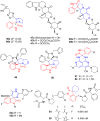Therapeutic Potential of Spirooxindoles as Antiviral Agents
- PMID: 27627626
- PMCID: PMC5417367
- DOI: 10.1021/acsinfecdis.6b00041
Therapeutic Potential of Spirooxindoles as Antiviral Agents
Abstract
Antiviral therapeutics with profiles of high potency, low resistance, panserotype, and low toxicity remain challenging, and obtaining such agents continues to be an active area of therapeutic development. Due to their unique three-dimensional structural features, spirooxindoles have been identified as privileged chemotypes for antiviral drug development. Among them, spiro-pyrazolopyridone oxindoles have been recently reported as potent inhibitors of dengue virus NS4B, leading to the discovery of an orally bioavailable preclinical candidate (R)-44 with excellent in vivo efficacy in a dengue viremia mouse model. This review highlights recent advances in the development of biologically active spirooxindoles for their antiviral potential, primarily focusing on the structure-activity relationships (SARs) and modes of action, as well as future directions to achieve more potent analogues toward a viable antiviral therapy.
Keywords: DENV; HIV; RSV; antiviral agents; influenza virus; spirooxindoles.
Conflict of interest statement
The authors declare no competing financial interest.
Figures







References
-
- Menendez-Arias L, Gago F. Antiviral agents: structural basis of action and rational design. Subcell Biochem. 2013;68:599–630. - PubMed
-
- Antiretroviral drugs used in the treatment of HIV infection. http://www.fda.gov/ForPatients/Illness/HIVAIDS/Treatment/ucm118915.htm.
-
- Wainberg MA. Perspectives on antiviral drug development. Antiviral Res. 2009;81:1–5. - PubMed
Publication types
MeSH terms
Substances
Grants and funding
LinkOut - more resources
Full Text Sources
Other Literature Sources
Medical
Miscellaneous

